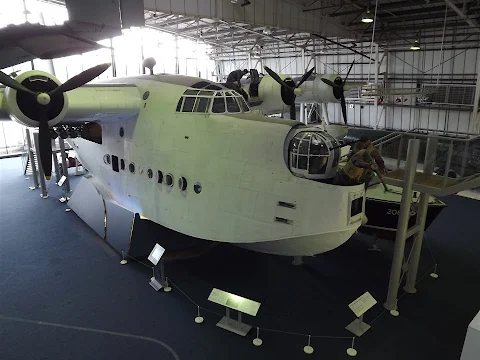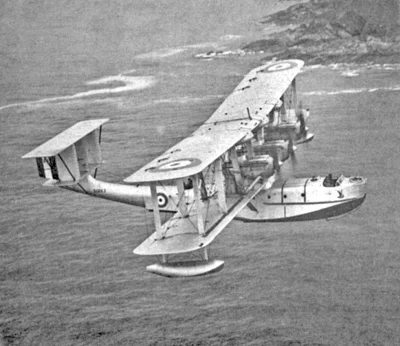Thursday, December 20, 2018
Imperial Airways
.
1920s Aviation Boom: Birth Of Commercial Aviation | Early Aviation | Spark > .
Imperial Airways was the early British commercial long-range airline, operating from 1924 to 1939 and principally serving the British Empire routes to South Africa, India and the Far East, including Australia, Malaya and Hong Kong. The airplanes provided seats for about 20 passengers, typically businessman or colonial administrators. Accidents were frequent: in the first six years, 32 people died in seven incidents. Imperial Airways never achieved the levels of technological innovation of its competitors, and was merged into the British Overseas Airways Corporation (BOAC) in 1939. BOAC in turn merged with the British European Airways (BEA) in 1974 to form British Airways.
The establishment of Imperial Airways occurred in the context of facilitating overseas settlement by making travel to and from the colonies quicker, and that flight would also speed up colonial government and trade that was until then dependent upon ships. The launch of the airline followed a burst of air route surveying in the British Empire after the First World War, and after some experimental (and often dangerous) long-distance flying to the margins of Empire.
Imperial Airways were the forerunner of BOAC, BEA and the British Airways of today. In 1924, the British Government amalgamated many of the complicated array of pioneering small British airlines into one company, Imperial Airways. Original newsreels give us a fascinating and detailed insight into early operations from London s first airport in Croydon - At first, the passengers flew in comfort while the pilot still sat in an open cockpit! By 1926, there were whole fleets of airliners and new flying boats were commissioned. Amy Johnson arrived from Australia in 1929 and by 1930 the new Handley Page four-engined airliners became reality. Pioneering is dangerous - as the R-101 Airship crash proved to the airlines. Imperial Airways even experimented with a radio link between The Flying Scotsman and one of its aircraft. Imperial Airways flew the first car and even transmitted Jack Hylton and his band live from the air. Throughout the 1930s, Imperial Airways kept expanding throughout the Empire over to Australia. We spend 24 hours in Sharjah and witness a nasty crash at Croydon! 1936 saw the birth of the new giant Empire flying boats and in 1937, Imperial Airways became air partners with Pan American and trans-oceanic flying was born. The hazards of ice, early air-to-air refuelling and the Short Mayo Composite aircraft are also shown and explained. Aircraft included : Handley Page W8, W9, W10 and HP42. Armstrong Whitworth Argosy and Atalanta. De Havilland DH50, DH66, DH86, DH91 and Albatross. Short S.8 'Calcutta', S.23 & S.30 'Empire' Flying Boats and the Mayo Composite The R-101 Airship and the Lockheed Electra
Comment: First flight of the Handley-Page HP.42, November 14, 1930, from Handley-Page Aerodrome, Radlett, Herts. The "German challenge" was the Junkers G.38, a 30-seat monoplane which first flew late in 1929. The famous Dornier Do X flying boat was of course much larger, but not a land plane.
As Mr Handley-Page points out, the liner came in 2 models: HP.42E for the eastern air routes (Cairo based), carrying 24 passengers plus extra freight and mails, and HP.42W for the western (European) routes, capacity 40 passengers. Four of each type were built, serving with Imperial Airways from 1931-'39 and then impressed into the RAF. All were destroyed in various accidents by 1941, including the herein featured "Hannibal", lost at sea with 8 aboard over the Gulf of Oman in 1940.
Imperial Airways & Flying Boats
.
Short Sunderland, etc - British Seaplanes That Terrorized U-Boats | War Stories > .1920s Aviation Boom: Birth Of Commercial Aviation | Early Aviation | Spark > .
Inside The Cockpit - Short Sunderland - MAH > .
How Britain Took to the Air - BBC High Flyers
https://www.youtube.com/watch?v=8kuDb9h_b9M .
https://www.youtube.com/watch?v=8kuDb9h_b9M .
Imperial Airways ..
Imperial Airways & Flying Boats ..
Wings of Luftwaffe - Sea Planes > .
https://www.youtube.com/watch?v=y_txMp1QVq8
Wings of Luftwaffe >> .
https://www.youtube.com/playlist?list=PLjRQ2YlHFA6dqL91NJjpHkQ_OVrsCtSEg .
Short Sunderland > .
https://www.youtube.com/watch?v=lFH2OZD-TcU
Short Sunderland
https://www.youtube.com/watch?v=g8-eX0cnwNw

Biplane Flying Boats
The Blackburn Iris was a British three-engined biplane flying boat of the 1920s. Although only five Irises were built, it was used as a long-range maritime reconnaissance aircraft by the Royal Air Force, where it equipped a squadron for four years, being used to carry out a number of notable long-distance flights. The final version of the Iris, the Iris Mark V was developed into the aircraft that replaced it in Squadron service, the Blackburn Perth.
https://en.wikipedia.org/wiki/Blackburn_Iris
The Blackburn Perth was a British flying boat in service during the interwar period. It was essentially an upgraded Iris, hence the largest flying-boat to serve with the Royal Air Force at the time (and the largest biplane flying boat ever to serve with the RAF).
https://en.wikipedia.org/wiki/Blackburn_Perth
The Short Singapore was a British multi-engined biplane flying boat built after the First World War. The design was developed into two four-engined versions: the prototype Singapore II and production Singapore III. The latter became the Royal Air Force's main long-range maritime patrol flying boat of the 1930s and saw service against the Japanese with the Royal New Zealand Air Force during the Second World War.
https://en.wikipedia.org/wiki/Short_Singapore
The Saunders Roe A.27 London was a British military biplane flying boat built by the Saunders Roe company. Only 31 were built, entering service with the Royal Air Force in 1936. Although due for replacement by the outbreak of World War II, they saw some active service pending the introduction of the ultimately unsuccessful Lerwick.
https://en.wikipedia.org/wiki/Saro_London
The Saunders-Roe A.36 Lerwick was a British flying boat built by Saunders-Roe Limited (Saro). It was intended to be used with the Short Sunderland in Royal Air Force Coastal Command but it was a flawed design and only a small number were built. They had a poor service record and a high accident rate; of 21 aircraft, 10 were lost to accidents and one for an unknown reason.
https://en.wikipedia.org/wiki/Saunders-Roe_A.36_Lerwick
New Seaplane Base - 1940 > .
https://www.youtube.com/watch?v=bFXgVUaH2l0
Imperial Airways & Flying Boats ..
https://www.youtube.com/watch?v=y_txMp1QVq8
Wings of Luftwaffe >> .
https://www.youtube.com/playlist?list=PLjRQ2YlHFA6dqL91NJjpHkQ_OVrsCtSEg .
https://www.youtube.com/watch?v=lFH2OZD-TcU
Short Sunderland
https://www.youtube.com/watch?v=g8-eX0cnwNw

a Look inside A Short Sunderland Flying Boat
Biplane Flying Boats
The Blackburn Iris was a British three-engined biplane flying boat of the 1920s. Although only five Irises were built, it was used as a long-range maritime reconnaissance aircraft by the Royal Air Force, where it equipped a squadron for four years, being used to carry out a number of notable long-distance flights. The final version of the Iris, the Iris Mark V was developed into the aircraft that replaced it in Squadron service, the Blackburn Perth.
https://en.wikipedia.org/wiki/Blackburn_Iris
The Blackburn Perth was a British flying boat in service during the interwar period. It was essentially an upgraded Iris, hence the largest flying-boat to serve with the Royal Air Force at the time (and the largest biplane flying boat ever to serve with the RAF).
https://en.wikipedia.org/wiki/Blackburn_Perth
The Short Singapore was a British multi-engined biplane flying boat built after the First World War. The design was developed into two four-engined versions: the prototype Singapore II and production Singapore III. The latter became the Royal Air Force's main long-range maritime patrol flying boat of the 1930s and saw service against the Japanese with the Royal New Zealand Air Force during the Second World War.
https://en.wikipedia.org/wiki/Short_Singapore
The Saunders Roe A.27 London was a British military biplane flying boat built by the Saunders Roe company. Only 31 were built, entering service with the Royal Air Force in 1936. Although due for replacement by the outbreak of World War II, they saw some active service pending the introduction of the ultimately unsuccessful Lerwick.
https://en.wikipedia.org/wiki/Saro_London
The Saunders-Roe A.36 Lerwick was a British flying boat built by Saunders-Roe Limited (Saro). It was intended to be used with the Short Sunderland in Royal Air Force Coastal Command but it was a flawed design and only a small number were built. They had a poor service record and a high accident rate; of 21 aircraft, 10 were lost to accidents and one for an unknown reason.
https://en.wikipedia.org/wiki/Saunders-Roe_A.36_Lerwick
https://www.youtube.com/watch?v=bFXgVUaH2l0
ISR - Intelligence, Signals, Reconnaissance
23-4-15 Tracking NATO's 2023 ISR Flights Around Ukraine - Such > .24-4-19 Over The Horizon Super Radars: Australia (JORN), US, Xina, Ruscia - S&AC > .
Reconnaissance, surveillance and target acquisition (RSTA): Main article: Reconnaissance, surveillance, and target acquisition (United States): RSTA is used by the US Army in place of STAR or ISTAR. Also, a term used to identify certain US Army units: for instance, 3rd Squadron, 153rd RSTA. These units serve a similar role to the below mentioned US Marine Corps STA platoons, but on a larger scale.
Surveillance and target acquisition (STA): Main article: Surveillance and target acquisition: Used to designate one of the following:● surveillance ..
EW - Electronic Warfare
GMD - Ground-Based Midcourse Defense > Air Defense >>
24-4-19 GMD - America's Missile Defense - T&P > .
ISR (Intelligence, Signals, Reconnaissance) is the coordinated and integrated acquisition, processing and provision of timely, accurate, relevant, coherent and assured information and intelligence to support commander's conduct of activities. Land, sea, air and space platforms have critical ISR roles in supporting operations in general. By massing ISR assets, an improved clarity and depth of knowledge can be established. ISR encompasses multiple activities related to the planning and operation of systems that collect, process, and disseminate data in support of current and future military operations.
Surveillance, target acquisition, and reconnaissance (STAR): A term used when emphasis is to be placed on the sensing component of ISTAR.
Reconnaissance, surveillance and target acquisition (RSTA): Main article: Reconnaissance, surveillance, and target acquisition (United States): RSTA is used by the US Army in place of STAR or ISTAR. Also, a term used to identify certain US Army units: for instance, 3rd Squadron, 153rd RSTA. These units serve a similar role to the below mentioned US Marine Corps STA platoons, but on a larger scale.
Surveillance and target acquisition (STA): Main article: Surveillance and target acquisition: Used to designate one of the following:
- A US Military Occupational Specialty (MOS) - specifically a STA United States Marine Corps Scout Sniper
- The role of a unit (e.g. STA patrol) or equipment
- A doctrine similar to ISTAR; for the US, and its allies and partners, its basis is the US National Defense Space Architecture (NDSA) as realized by layered constellations of Earth satellites and Earth stations.
➾ 2022 ..
Subscribe to:
Comments (Atom)
sī vīs pācem, parā bellum
igitur quī dēsīderat pācem praeparet bellum therefore, he who desires peace, let him prepare for war sī vīs pācem, parā bellum if you wan...

-
>>> Economic > >>> Geopolitics > >>> Military > >>> Resources > > >> Sociopoli...
-
2025 Fiasco; Christo-Fascist Project 2025 2025 Blueprint for Theocracy - αλλο >> . 2025 Christo-Fascist Blueprint for Autocracy - Shr...
-
> > Alliances > > > > Authoritarianism > > > Axis of Envious Resentment 2025 > > > > Civil...

